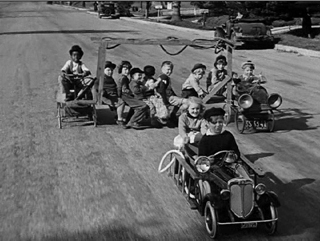Who Remembers Building a Go-Cart?
My youngest son (far right) and I were having a conversation about my life and the things I did as a kid.
“We built wooden go-carts and clubhouses, made slingshots and tried to make a parachute out of a trash bag,” I said.
My son laughed and asked,” How old were you?”
“I was 8 years old when I started with my three friends,” I said.
This shocked him because I grew up in Philadelphia. It is sometimes assumed that this kind of stuff only happened in suburban and rural areas. Does it shock you? If you grew up as part of Gen X or before in the U.S., it shouldnt. My generation (Gen X) was the last to grow up without computers in the home. When the personal computer revolution happened in the 1980s, I was in my teen years. Other radical inventions eventually followed such as computer graphics programs, the internet, etc. Today, Information and Communications Technologies (ICTs) is everywhere in our homes and with us everywhere we go. Multiple screen interaction is becoming the norm. One example is TV shows that encourage tweeting while watching. Also, since the perception of the U.S. today is that it is less safe than 30 years ago, ICTs serve as a distraction and occasional childsitter.
So, I am helping my 11 year old son and three of his friends build a basic wooden two seater go-cart.This 5-week process (4 hours/week) is as follows:
- Watch a video clip about building go-carts and discuss what we have time to do, roles, what might work and what may not.
- Each kid draws a blueprint on graph paper and show the go-cart from the the side, back, front and aerial view. As a group, discuss what to put on it and why.
- Each kid builds a basic prototype using crafts store materials. Discuss the specific mechanics of each go-cart part and the simplest way to construct them.
- As a group, draw the actual size of the go-cart on the sidewalk to determine dimensions. Write measurements on the blueprint.
- As a group, take a trip to various stores to buy the parts. Determine type and thickness of wood and screws to use.
- Decide on specific assembly roles (putting on wheels, seats, cutting wood, etc) and build.
- Test in an empty parking lot then move on to a moderate hill in the park. Invite parents.
Right now, we just completed #3 of the process. So, in hindsight, what did I learn as a kid building go-carts with my friends?
- Spatial ability: Reasoning skills that refers to the capacity to think about objects in three dimensions and to draw conclusions about those objects from limited information. Designers call this visualization.
- Advanced motor skills: Enhanced ability to handle and use, in a safe way, power (drill, jigsaw, etc) and basic tools (ruler, screwdriver, hammer, etc).
- Critical Thinking: Learning how to test a hypotheses (will this type of brake work?), deal with failure, analyze data and construct deductive arguments.
- Group Dynamics: Understanding the role each person has in the group and finding a way to benefit from what they know and can do.
Now, when comparing my go-cart building experiences, there are some differences. My friends and I had more concentrated time because we lived within blocks of each other. We built crude prototypes using rubber bands and popsicle sticks found on the sidewalk. Also, we found the materials to build the go-cart by canvassing our neighborhood. As a result, our failure rate was high and sometimes our go-cart looked like something the Little Rascals would be proud of. LOL
Honestly, I did not know I was exercising all of the above bullet points as a kid. But these experiences prepared me for more complex tasks and projects as an adult.
Can video games do these things? Possibly but a few are in question. Spatial ability may not factor in because video games are obviously much more media rich today. Kids aren’t challenged to think too abstractly. Group Dynamics is somewhat possible. When I visited South Korea five years ago, I heard about their social gaming cafes where anyone could pay a hourly fee to engage in multiplayer games. Social gaming is a disembodied experience because even though gamers are physically present, they are primarily interacting in virtual reality. The downside is that some South Korea teens exhibit signs of real internet addiction. Six months ago in Taiwan, a gamer died after game marathoning for three days straight.
[tweetthis remove_twitter_handles=”true”]Something is being lost with the proliferation of screens that young people can access and disappear into for hours.[/tweetthis] This commercial by Nature Valley captures it. Although they classify it as rediscovering nature, all of my bullet points apply.
https://www.youtube.com/watch?v=30FQJJ3kHok
Just so you know, I understand the irony here. I am talking about developing certain skills away from ICTs and I am writing on Linkedin right now. True, but for the record, my exposure to go-cart building along with other experiences has helped prepare me to operate my branding and design business. I engage in sketching (logo ideas, etc), word association exercises (developing messaging, etc), market research and doing presentations/workshops for clients. The four bullet points are represented in these tasks. I want my son and his friends to develop these skills. (Other parents are involved teaching baking and wilderness skills on other days.)
Helping my son and his friends build this go-cart will hopefully spark other ideas. Its already happening. (One kid suggested we build a go-cart with a motor. That is above my pay grade. LOL) Maybe they might let me ride in it and relive some glory days. I will post the outcome of this project in August.
Thanks for taking the time to read this article. Your shares, likes and comments are appreciated. What did you build as a child that has helped you as an adult?

